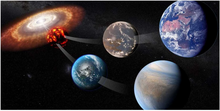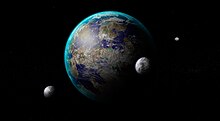
An Earth analog, also called an Earth analogue, Earth twin, or second Earth, is a planet or moon with environmental conditions similar to those found on Earth. The term Earth-like planet is also used, but this term may refer to any terrestrial planet.
The possibility is of particular interest to astrobiologists and astronomers under reasoning that the more similar a planet is to Earth, the more likely it is to be capable of sustaining complex extraterrestrial life. As such, it has long been speculated and the subject expressed in science, philosophy, science fiction and popular culture. Advocates of space colonization and space and survival have long sought an Earth analog for settlement. In the far future, humans might artificially produce an Earth analog by terraforming.
Before the scientific search for and study of extrasolar planets, the possibility was argued through philosophy and science fiction. Philosophers have suggested that the size of the universe is such that a near-identical planet must exist somewhere. The mediocrity principle suggests that planets like Earth should be common in the Universe, while the Rare Earth hypothesis suggests that they are extremely rare. The thousands of exoplanetary star systems discovered so far are profoundly different from the Solar System, supporting the Rare Earth Hypothesis.
On 4 November 2013, astronomers reported, based on Kepler space mission data, that there could be as many as 40 billion Earth-sized planets orbiting in the habitable zones of Sun-like stars and red dwarf stars within the Milky Way Galaxy.[1][2] The nearest such planet could be expected to be within 12 light-years of the Earth, statistically.[1][2] In September 2020, astronomers identified 24 superhabitable planets (planets better than Earth) contenders, from among more than 4000 confirmed exoplanets, based on astrophysical parameters, as well as the natural history of known life forms on the Earth.[3]
On 11 January 2023, NASA scientists reported the detection of LHS 475 b, an Earth-like exoplanet — and the first exoplanet discovered by the James Webb Space Telescope.[4]

Scientific findings since the 1990s have greatly influenced the scope of the fields of astrobiology, models of planetary habitability and the search for extraterrestrial intelligence (SETI).
- ^ a b Overbye, Dennis (4 November 2013). "Far-Off Planets Like the Earth Dot the Galaxy". The New York Times. Retrieved 5 November 2013.
- ^ a b Petigura, Erik A.; Howard, Andrew W.; Marcy, Geoffrey W. (1 November 2013). "Prevalence of Earth-size planets orbiting Sun-like stars". Proceedings of the National Academy of Sciences. 110 (48): 19273–19278. arXiv:1311.6806. Bibcode:2013PNAS..11019273P. doi:10.1073/pnas.1319909110. PMC 3845182. PMID 24191033.
- ^ Schulze-Makuch, Dirk; Heller, Rene; Guinan, Edward (18 September 2020). "In Search for a Planet Better than Earth: Top Contenders for a Superhabitable World". Astrobiology. 20 (12): 1394–1404. Bibcode:2020AsBio..20.1394S. doi:10.1089/ast.2019.2161. PMC 7757576. PMID 32955925.
- ^ Cite error: The named reference
NBC-20230111was invoked but never defined (see the help page).